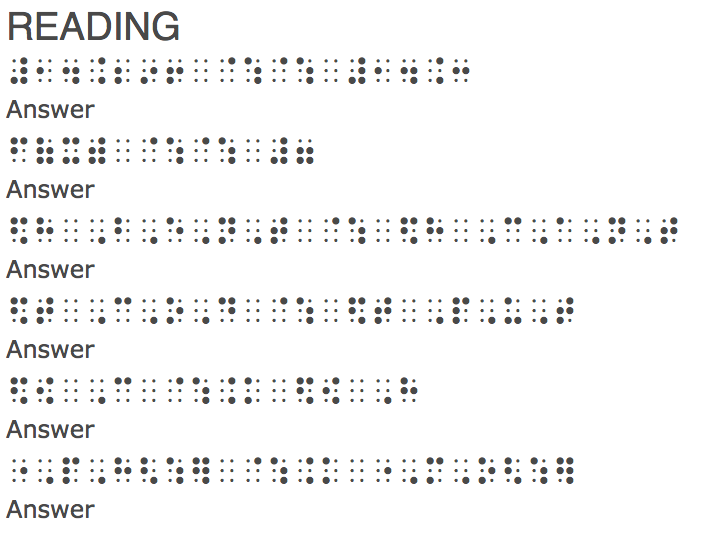Nemeth Tutorial from APH
Submitted by Charlotte Cushman on Sep 25, 2021

What is Nemeth Code?
Nemeth Code is the standard code of braille notation used for math and science. It was developed by Dr. Abraham Nemeth in 1946, and was adopted by BANA (Braille Authority of North America) in 1952 as the standard code to represent mathematic and scientific notation, using the 6-dot braille cell.
How Can I Learn Nemeth Code?
The Nemeth Tutorial is a project with American Printing House for the Blind (APH) that is designed to teach students and teachers how to use the Nemeth code for all levels of mathematics, from introductory to advanced topics.
There are 11 chapters are organized by grade level, from 1st to 8th grade, and then by content area for algebra, geometry and advanced mathematics.
Table of Contents
Chapter One: First Grade
- 1.1 The Numeric Indicator
- 1.2 Punctuation
- 1.3 Comma
- 1.4 Plus and Minus Signs
- 1.5 Equals Sign
- 1.6 Signs of Comparison
Chapter Two: Second Grade
- 2.1 Abbreviations
- 2.2 Decimal Point
- 2.3 Monetary Sign: Dollar and Cent
Chapter Three: Third Grade
- 3.1 Multiplication Cross
- 3.2 Division
- 3.3 Parentheses
- 3.4 Simple Fractions
- 3.5 Omission Symbol
- 3.6 Roman Numerals
- 3.7 Mixed Fraction
- 3.8 Introduction to Nemeth Indicator
Chapter Four: Fourth Grade
- 4.1 Variables
- 4.2 Shapes Omissions
- 4.3 Ratios and Percents
- 4.4 Degrees
- 4.5 Basic Geometric Symbols
Chapter Five: Fifth Grade
- 5.1 Basic Exponents
- 5.2 Segments, Lines, Rays and their Relationship
- 5.3 Directed Signed
- 5.4 Ordered Pairs
Chapter Six: Sixth Grade
- 6.1 Absolute Value
- 6.2 The Horizontal Bar - Repeating Decimals, Greater than or equal to, and Less than or equal to
- 6.3 Brackets and Braces
Chapter Seven: Seventh Grade
- 7.1 Complex Fractions
Chapter Eight: Eighth Grade
- 8.1 Real Numbers
- 8.2 Plus/Minus and Not Equal Sign
Chapter Nine: Algebra
- 9.1 Set Notations: Complements, Subsets, Union, Intersection
- 9.2 Ratios and Proportions
- 9.3 More Sets: Union, Intersections and the Infinity Symbol
- 9.4 Matrices
- 9.5 Factorial
Chapter Ten: Geometry
- 10.1 Signs of Comparison: Approximately Equal To, Similar To, Congruent To
- 10.2 Conjunction, Disjunction, Conditionals, and Biconditionals
Chapter Eleven: Advanced Mathematics
- 11.1 Subscripts
- 11.2 Funtion Name Abbreviation
- 11.3 Vectors
- 11.4 Circles and Arcs
- 11.5 Additional Shapes
- 11.6 More Complex Radicals
- 11.7 Sigma Notation
- 11.8 Limits
- 11.9 Integrals
- 11.10 Logic and Set Theory
- 11.11 Caret and Partial Derivative
- 11.12 Logical Operators For All, There Exists, and Therefore
- 11.13 Greek Letters
- 11.14 Tally Marks
- 11.15 Type Faces

Comments
working with visually